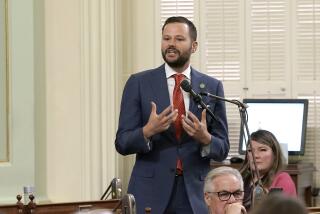Cuts in paid sick days leave unhealthy employees stuck in the workplace
STAY home if you’re sick. That’s the best way to stop the spread of contagious diseases, such as influenza, tuberculosis and gastrointestinal viruses. Besides, you can’t do your job capably or safely if you don’t feel well. But many Americans simply tough it out when ill, going to work with pain, cramps, headaches, fevers or worse. Often, they have no choice.
As many as 43% of American workers in private industry don’t have paid sick days, according to 2007 data from the federal government. If they call in sick, they lose their pay and, sometimes, their jobs.
That number has risen over the years, part of a larger trend to cut back on sick leave. Among workers who do still have the once-venerable benefit, many have found their days reduced or lumped together as part of their vacation time. The United States -- unique among industrialized countries -- doesn’t mandate a minimal number of paid sick days for workers.
“Sick time is changing,” says Kim Stattner, an expert on absence management for Hewitt Associates, an international company that provides human resources programs and consulting. “The practices and designs are not as generous as they once were.”
As employers cut back, however, lawmakers are stepping in, with the support of labor organizations and health officials. In May, legislation cleared the California Assemblythat would allow workers to earn one hour of paid sick time for every 30 hours worked. The bill, called Healthy Families, Healthy Workplaces (AB 2716), has been sent to the Senate, where its prospects for passage are considered fair.
As many as 10 other states are also pondering paid-sick-day laws, including Ohio, where residents will likely vote in November on a ballot initiative requiring a minimum number of paid sick days.
Two cities, San Francisco and Washington, D.C., have already enacted legislation. In San Francisco, full-time, part-time and temporary workers earn one hour of paid sick leave for every 30 hours worked, assuming they have been on the job for at least three months. Workers at companies with fewer than 10 employees can accumulate up to five days per year, and workers for companies with 10 or more workers can accumulate up to nine days. The Washington, D.C., law requires workers to be on the job for one year before becoming eligible for paid sick leave. Workers can earn three to seven days depending on the size of their company and whether they work full or part time.
About 135 developed countries have laws requiring private and public employers to provide paid sick leave to full-time employees. In the United States, Sen. Edward M. Kennedy (D-Mass.) and Rep. Rosa L. DeLauro (D-Conn.) have introduced a bill, the Healthy Families Act, that would require businesses with 15 or more employees to give workers at least seven paid sick days per year.
“The public supports it,” says Ruth Milkman, a professor of sociology at UCLA and director of the Institute for Research on Labor and Employment. who has studied the proposed laws. “In San Francisco, the law was so popular that the people who were opposed to it didn’t even mount a challenge. Paid sick time is a human need that is self-evident.”
A worker’s struggle
Kathleen Martinez, 43, is typical of the kind of worker who is most likely to lack paid sick days. The Antioch, Calif., woman works part-time at two low-paying jobs, one as a pizza cook at a grocery store and another at a restaurant. Neither job provides paid sick days and one employer gives her “negative points” for being out sick. If she accrues too many negative points, she says, she’ll get fired.
Martinez was fired from her last job because she took all five of her allotted paid sick days plus some unpaid days when her daughter had recurrent ear infections and required surgery to insert ear tubes. She is a single parent and also cares for her mother, who has heart and lung diseases, and her grandmother, 87.
She says she can’t afford to lose another job: “I go to work when I have the flu. My bones can be aching, but I am so worried about getting negative points.”
Martinez recently discovered she has gynecological cancer, however, and will take a month off to recover from surgery, scheduled for Monday. Even if she doesn’t lose her jobs, she worries about the loss in pay.
“I rob Peter to pay Paul,” she says. “Whenever I’m sick or my daughter or relatives are sick, it takes me a couple of months to catch up with the bills.”
An estimated 79% of low-wage workers and 80% of part-time workers do not have paid sick time, according to the Institute for Women’s Policy Research, a Washington, D.C-based organization that based its analysis on U.S. Department of Labor statistics. The demand for workers in the service sector has grown substantially over the last two decades, but those jobs are much less likely to carry sick pay, says Jeremy Smith, a lobbyist for the California Labor Federation. Fewer workers today are covered by union contracts, which traditionally dictate paid sick time for their members, he adds.
Small companies are also chipping away at the benefit, often as a way to save money in other areas, says Stattner.
“Some employers look to generate savings from cutting sick time because they are trying to mitigate the cost increase of medical benefits,” she says.
Those employers, and many others, will resist legislation to mandate a certain number of paid sick days, says Peter Ronza, an advisor on employee compensation for the Society for Human Resource Management.
“They still love their people, but they can’t afford the kind of benefits that 3M or Best Buy or General Motors can afford,” he says. “California is saying, ‘OK, we need to have this as a paid benefit.’ But it turns out to be something small businesses can’t afford.”
Companies’ new tacks
Many employers have already begun to tinker with sick days.
The brokerage giant Merrill Lynch raised eyebrows last year when it sliced guaranteed sick days for employees from 40 to three. According to Stattner, most companies that provide paid sick days offer about 10 per year. (Employees of the federal government get 13 a year.) Fewer companies than in past years allow employees to carry over unused sick days from one year to the next, but many provide a short-term disability benefit featuring partial pay for six to eight weeks. Moreover, some companies allow employees to purchase long-term disability insurance policies.
“Today, sick time is intended for casual or incidental absences,” Stattner says. “The short-term disability is for more serious health conditions requiring multiple weeks away from the office.”
Employers are also becoming enamored of plans that lump vacation, sick and personal days in one pool, a benefit referred to as “paid time off.” A survey by Hewitt showed that 30% of employers offered paid time off in 2006, up from 18% in 2000.
The idea behind general paid time off is that employees will be more judicious in how they use sick time. But such pools often don’t reflect the realities of real life, Ronza says. “What if you get sick and you use up all your time in the same year that you have a wedding planned?”
Others view the time-off pools as a sneaky way to reduce paid sick days and ease the managerial headache of keeping track of employees’ separate balances of sick, personal and vacation days. When employers offer 15 days of time off instead of two weeks of vacation and two weeks of sick time, for example, the reduced number of sick days can slip by relatively unnoticed.
“It’s a way of cutting back on paid time off,” says Vicky Lovell, director of employment and work/life programs for the Institute for Women’s Policy Research. “Employers don’t have to care why someone is out.”
Considering that humans have employed other humans since the days of the ancient Romans, it’s odd that no one really has a good grasp of what constitutes a fair number of sick days per year, Ronza says. According to the 2004 National Health Interview Survey, a government-conducted poll, the average worker takes off 3.9 days per year for their own illnesses or injuries and 1.3 days to care for ill family members. According to Lovell, 3.5 hours are needed on average for one’s own preventive health care.
But, Stattner says: “A paid-time-off bank breaks down those barriers. If you need 20 days off because you have an ill child, you have access to 20 days. You may have to use up some of your vacation time, but the person gets to choose.”
With more emphasis on preventive care as a means to reduce the long-term cost of healthcare, a few bold employers are offering employees one or two days a year specifically for prevention, Stattner says. Others reward employees who don’t use paid sick days by exchanging them for vacation time. Surveys show that nearly half of all workers each year do not miss a single day of work due to illness.
“The lack of utilizing sick time is a reflection of the employee’s dedication to the job,” she says. “Organizations do place value on those behaviors.”
More to Read
Inside the business of entertainment
The Wide Shot brings you news, analysis and insights on everything from streaming wars to production — and what it all means for the future.
You may occasionally receive promotional content from the Los Angeles Times.










